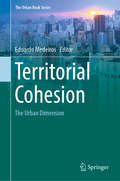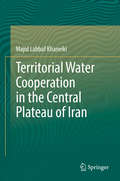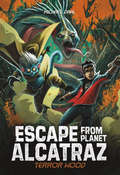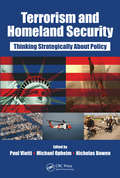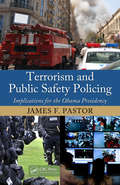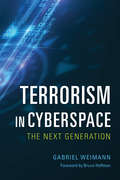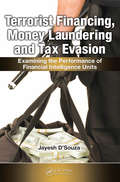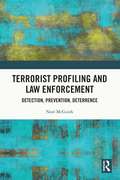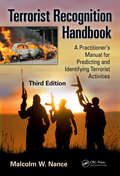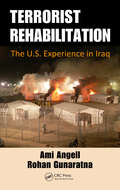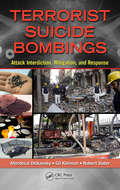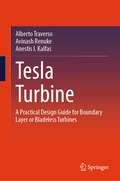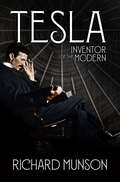- Table View
- List View
Terricolous Lichens in India
by Himanshu Rai Dalip K. UpretiTerricolous lichens, a habitat specialist group of lichens play a vital role in maintenance and ecological stability of soil crusts with reference to their physical stability, hydrology and growth of soil microflora. Terricolous lichens in Indian lichenological studies haven't been taken up as a functional group. Terricolous Lichens in India, Volume 1: Diversity Patterns and Distribution Ecology is the first ever publication dealing with soil lichens of India. Divided into five chapters, this volume discusses the lichenological researches in India with reference to terricolous lichens, the altitudinal distribution patterns of terricolous lichens, comparative assessment of distribution with global patterns, and the photobiont diversity and influence of novel molecular clades of photobiont in determining ecological preferences of soil lichens in India. Written by experts in the field and supplemented with numerous photographs, Terricolous Lichens in India, Volume 1: Diversity Patterns and Distribution Ecology is a comprehensive resource that addresses the major drivers of terricolous lichens distribution in India.
Territorial Cohesion: Cohesion, Development, Impact Assessment And Cooperation (Routledge Advances In European Politics Ser.)
by Eduardo MedeirosThis book offers a comprehensive overview of several urban related aspects that are of central importance to successful territorial cohesion processes. In essence, it sheds new light on issues concerning urban polycentrism, functional urban regions, integrated sustainable urban development, and the EU Urban Agenda; and on how they can help to achieve territorial cohesion policy goals. As an elusive and fairly recent concept, territorial cohesion has to date only been vaguely debated in the available literature, which for the most part focuses on its historical origins and its relevance for EU policymaking. Instead, this book synthesizes, for the first time, a range of perspectives that place urban elements and policies at the core of territorial cohesion analysis. As such, and given the fact that territorial cohesion is a holistic concept, the book will appeal to a broad readership from both the academic and policymaking arenas.
Territorial Development and Water-Energy-Food Nexus in the Global South: A Study for the Maputo Province, Mozambique (Research for Development)
by Alessandro Frigerio Laura Montedoro Alice BuoliThis volume collects the results from the Politecnico di Milan’s award-winning “Boa_Ma_Nhã, Maputo!” research-by-design project, which studied various transdisciplinary approaches to development in the context of the Global South. The challenges of urbanization are well known, but that only goes so far in aiding implementation. From local considerations like water access and housing rights to global issues like climate change, territorial development demands solutions that address the needs of the specific population while keeping such goals as sustainability and inclusion in mind. By focusing on a number of towns within the Maputo Province of Mozambique, and thus addressing many of the issues endemic to Sub-Saharan Africa, the research, structurally presented so as to aid those who may require introduction to the issue, makes a clear case in favor of always keeping the Water-Energy-Food (WEF) Nexus in mind when formulating development strategies for improving people’s lives, as well as the wisdom of marrying academic findings with the insights accrued by local NGOs and institutions, thereby expanding the potential idea bank beyond the Eurocentric status quo that has tended to dominate the field.
Territorial Ecology and Socio-ecological Transition
by Nicolas BucletIn the same realm as social ecology, industrial ecology and the circular economy, a new interdisciplinary field is growing: territorial ecology. Based on the analysis of the metabolism of human societies at a local level, it helps us diagnose a socioecosystem. This diagnostic is not only based on what is circulating, but also on how it is organized and why. Who is at the origin of a flow? What are their motivations? Who has the power to make decisions about it? This methodology, taking into account both the material description of human societies and the analysis of decisionmaking processes, might also be relevant for territorial diagnostics. It leads us to a systemic view of the consequences of individual and collective actions on the sustainability of local socio ecosystems. Socio-ecological transition implies a substantial evolution of human societies. Innovation, be it technological, organizational or social, is intrinsically involved in this evolution. However, if transition calls for disruptive rather than incremental innovations, we must also assess these innovations with a systemic view of their consequences.
Territorial Fragilities in Cyprus: Planning and Preservation Strategies (Research for Development)
by Alice Buoli Oana Cristina ŢiganeaIn this book, the authors present a combination of research-by-design, place-based, and policy-oriented approaches to the territorial fragilities of Nicosia. Nicosia, in Cyprus, is a city divided. Since 1974, a 180 km long Buffer Zone has separated the Turkish Republic of Northern Cyprus (TRNC) and the Republic of Cyprus (RoC). This "open wound" cuts through the city's historical center, crossing the Venetian walls, a key cultural heritage asset, and impacting the city's spatial and cultural identity. Outcomes of an inter-doctoral research initiative, this edited book documents the local realities of the divided city and tests scenarios and spatial patterns of intervention to cope with the partition through the enhancement of local cultural heritage.The book targets an academic audience, architects, urban planners, heritage preservation professionals and policymakers, providing a transferable research method relevant to those approaching a complex, fragile, and contested "border territory".
Territorial Innovation in Less Developed Regions: Governance, Technologies, and Sustainability (Palgrave Studies in Sub-National Governance)
by Filipe Teles Carlos Rodrigues Fernando Ramos Anabela BotelhoThis book examines the roles of communities in the general framework of territorial innovation, particularly in the context of less developed regions. With a specific focus on Portugal, it offers conceptual improvements that will be of use to other European regions. The book will appeal to scholars and students of regional governance and politics, from public administration to economics, sociology, geography and political science, as well as to practitioners.
Territorial Landscapes Solutions for Sustainable Energy and Food Security (Sustainable Landscape Planning and Natural Resources Management)
by Mourad Amer Mohamed El Kaftangui Ibrahim El-Sayed Maarouf Nauman Khalid Sharul Sham Bin DolThis book introduces a model for the built environment, designed to incorporate sustainability at every level. It emphasizes the integration of environmental, social, and economic factors to create resilient urban spaces. Also, it presents a decision support system that optimizes energy management for sustainability, enabling real-time adjustments and reducing carbon footprints. It discusses innovative strategies for managing water and wastewater in swampland areas, offering insights from UIN Raden Fatah Palembang's adaptation efforts. Also, this book provides a thorough review of bio-based business models, examining their agility and adaptability in fostering sustainable innovations that respond to market and environmental changes. Moreover, the book explores a novel approach to renewable energy, this chapter assesses the feasibility of using vortex bladeless wind turbines for energy generation at airport runways, offering both conceptual and economic analyses. In addition to discuss the creation and role of multi-actor forums in promoting a sustainable blue economy in the Black Sea region, emphasizing collaborative efforts to preserve marine resources. This book investigates the use of halophyte biochar as a sustainable soil amendment for sandy soils, demonstrating its potential to improve soil quality and promote sustainable agriculture. Also, the book aims to assess the sustainability of food-energy-water systems at the household level, advocating for integrated solutions that enhance resource efficiency and sustainability. This book delves into societal perceptions of climate change adaptation, using interaction analysis to better understand public attitudes and their implications for policy and communication strategies. This book presents a case study from Istanbul, offering insights into how local identity can strengthen community resilience and sustainability efforts. Finally the book provides a comprehensive guide to understanding and implementing sustainable practices across various sectors, from energy management and water resources to food systems and environmental education. It emphasizes the importance of interdisciplinary approaches and innovation agility in addressing global sustainability challenges.
Territorial Water Cooperation in the Central Plateau of Iran
by Majid Labbaf KhaneikiThis book tries to answer the question how different communities in such an arid area as the Iranian central plateau could have shared their limited water resources in a perfect harmony and peace over the course of history. They invented some indigenous technologies as well as cooperative socio-economic systems in order to better adapt themselves to their harsh environment where the scarce water resources had to be rationed among the different communities as sustainably as possible. Those stories hold some lessons for us on how to adjust our needs to our geographical possibilities while living side by side with other people. This work gives insight into the indigenous adaptation strategies through the territorial water cooperation, and describes how water can appear as a ground for cooperation. It explains the water supply systems and social aspects of water in central Iran. Topics include the territorial water cooperation, qanat’s, the traditional water management and sustainability, the socio-economic context, the sustainable management of shared aquifers system and more.
Terror Wood (Escape from Planet Alcatraz)
by Michael DahlErro and Zak Nine are hiding in the Phantom Forest, a dark wood filled with giant, towering trees and dangerous beasts. The boys hide high above the ground, climbing and jumping between the tree branches. So far they've avoided dangerous creatures such as huge, hairy rats and giant, bloodthirsty spiders. But a new predator has caught the boys' scent. An enormous flying serpent chases after them and won't stop until its hunger is satisfied! How will Zak and Erro avoid becoming dinner for this deadly new monster?
Terrorism and Homeland Security (Eighth Edition)
by Jonathan R. WhiteWritten by acclaimed national terrorism expert Jonathan R. White, the market-leading TERRORISM AND HOMELAND SECURITY is widely recognized as the most comprehensive, balanced, and objective terrorism book available. In the Eighth Edition, White continues to provide a theoretical and conceptual framework that enables readers to understand how terrorism arises and how it functions. Packed with cutting-edge coverage, the book discusses the most sophisticated theories of the world's best terrorist analysts, while still focusing on the domestic and international threat of terrorism and the basic security issues surrounding terrorism today.
Terrorism and Homeland Security: Perspectives, Thoughts, and Opinions
by Dale L. JuneSince 9/11, the terms homeland security and terrorism have become firmly entrenched in our lexicon. The days of walking through a simple metal detector at the airport are over, and our security landscape is forever changed. Terrorism and Homeland Security: Perspectives, Thoughts, and Opinions brings together the work of academic researchers and law
Terrorism and Homeland Security: Thinking Strategically About Policy
by Paul R. Viotti Nicholas Bowen Michael A. OpheimDespite the fact that the Department of Homeland Security (DHS) has been active since November of 2002, the American homeland is still not secure from terrorist attack. What passes as DHS strategy is often just a list of objectives with vague references to the garnering of national resources, and the marshalling of support from other nations. Drawi
Terrorism and Public Safety Policing: Implications for the Obama Presidency
by James F. PastorThe trends, data, and battle-tested logic don't lie. A perfect storm of extremist ideologies is on the horizon that threatens to challenge the current state of public safety forcing police chiefs, public administrators, and security professionals to rethink their approach to policing the streets of America. Professor James Pastor, a recognized auth
Terrorism and WMDs: Awareness and Response, Second Edition
by John PichtelTerrorism and WMD’s, Second Edition provides a comprehensive, up-to-date survey of terrorism and weapons of mass destruction (WMDs). Terrorist weapons and delivery methods are becoming increasingly sophisticated; as such, this book focuses on the chemistry and biology of WMDs, the development and history of their use, and human health effects of such weapons. Coverage of new threats, additional case studies, and the emergence of ISIL—and other terrorist actors—have been added to the new edition which will serve as an invaluable resources to students and professionals studying and working in the fields of terrorism, Homeland Security, and emergency response.
Terrorism in Cyberspace: The Next Generation
by Gabriel WeimannThe war on terrorism has not been won, Gabriel Weimann argues in Terrorism in Cyberspace, the successor to his seminal Terror on the Internet. Even though al-Qaeda's leadership has been largely destroyed and its organization disrupted, terrorist attacks take 12,000 lives annually worldwide, and jihadist terrorist ideology continues to spread. How? Largely by going online and adopting a new method of organization. Terrorist structures, traditionally consisting of loose-net cells, divisions, and subgroups, are ideally suited for flourishing on the Internet through websites, e-mail, chat rooms, e-groups, forums, virtual message boards, YouTube, Google Earth, and other outlets. Terrorist websites, including social media platforms, now number close to 10,000. This book addresses three major questions: why and how terrorism went online; what recent trends can be discerned—such as engaging children and women, promoting lone wolf attacks, and using social media; and what future threats can be expected, along with how they can be reduced or countered. To answer these questions, Terrorism in Cyberspace analyzes content from more than 9,800 terrorist websites, and Weimann, who has been studying terrorism online since 1998, selects the most important kinds of web activity, describes their background and history, and surveys their content in terms of kind and intensity, the groups and prominent individuals involved, and effects. He highlights cyberterrorism against financial, governmental, and engineering infrastructure; efforts to monitor, manipulate, and disrupt terrorists' online efforts; and threats to civil liberties posed by ill-directed efforts to suppress terrorists' online activities as future, worrisome trends.
Terrorist Financing, Money Laundering, and Tax Evasion: Examining the Performance of Financial Intelligence Units
by Jayesh D'SouzaTracking funding is a critical part of the fight against terrorism and as the threat has escalated, so has the development of financial intelligence units (FIUs) designed to investigate suspicious transactions. Terrorist Financing, Money Laundering, and Tax Evasion: Examining the Performance of Financial Intelligence Units provides a thorough analy
Terrorist Profiling and Law Enforcement: Detection, Prevention, Deterrence
by Noel McGuirkThis book analyses the usefulness of terrorist profiling utilised by law enforcement officers as a pre-emptive means to assist them in the detection, prevention and deterrence of terrorism and/or its preparatory activities. It explores two main themes arising from the phenomenon of terrorist profiling: the lawfulness of terrorist profiling and the utility of profiling. These two themes are explored in three separate parts. Firstly, the book begins by drawing upon human rights concerns arising from the use of terrorist profiling by law enforcement officers. Secondly, an analytical framework capable of making determinations on the usefulness of terrorist profiling. This framework develops a profiling spectrum that ranges from formal and informal manifestations of terrorist profiling that forms the basis for evaluating its usefulness. Finally, the book presents an examination of various manifestations of terrorist profiling by separating the analysis of the ‘construction’ of profiles on the one hand, from their ‘application,’ on the other, so as to be able to identify and examine profiling’s usefulness as a technique to assist law enforcement officers make predictions about likely offender characteristics. This book ultimately concludes that terrorist profiling should only be conducted by undertaking a systematic assessment of the construction of profiles separate from the application of profiles whilst simultaneously taking into account fundamental human rights concerns with the practice of terrorist profiling. The work will be an essential resource for academics, law enforcement officers and lawyers in the disciplines of law, criminology, human rights, criminal justice and policing. As the book engages with terrorist profiling, it will also be of interest to those engaged in the psychology of terrorism.
Terrorist Recognition Handbook: A Practitioner's Manual for Predicting and Identifying Terrorist Activities, Third Edition
by Malcolm W. Nance Desmond WengerFirst published in 2003, Terrorist Recognition Handbook: A Practitioner's Manual for Predicting and Identifying Terrorist Activities remains one of the only books available to provide detailed information on terrorist methodology revealing terrorist motivation, organizational structure, planning, financing, and operational tactics to carry out atta
Terrorist Rehabilitation: The U.S. Experience in Iraq
by Rohan Gunaratna Ami AngellBecause terrorists are made, not born, it is critically important to world peace that detainees and inmates influenced by violent ideology are deradicalized and rehabilitated back into society. Exploring the challenges in this formidable endeavor, Terrorist Rehabilitation: The U.S. Experience in Iraq demonstrates through the actual experiences of m
Terrorist Suicide Bombings: Attack Interdiction, Mitigation, and Response
by Robert Slater Mordecai Dzikansky Gil KleimanUrban environments are prime targets for suicide bombings over the next decade. While the threat may be ever-present, measures are available that can empower law enforcement personnel to thwart attacks, or at least mitigate the effects by reducing casualties. Written by professionals with first-hand experience, Terrorist Suicide Bombings: Attack In
Tesla Turbine: A Practical Design Guide for Boundary Layer or Bladeless Turbines
by Alberto Traverso Avinash Renuke Anestis I. KalfasThis book aims at providing the reader with up-to-date knowledge about Tesla turbine features, mechanical design, and performance characteristics. A Tesla machine, in general, is characterised by the absence of rotating blades, therefore it is also called bladeless or boundary layer machine. In this book, suitable numerical approaches for the fluid-dynamic analysis are described, with practical examples related to physical prototypes designed, built and operated by the Authors. Interest in small scale turbines is growing mainly for energy efficiency and power recovery in a variety of applications. Considering small scales, conventional bladed turbines impose manufacturing limitations, lower performance and higher cost, which hinder their implementation. Tesla bladeless turbomachines are being re-discovered due to many advantages such as their simple design and ease of manufacturing with acceptable performance, especially for small-scale power generation and energy harvesting. To contribute to the spread of efficient and viable Tesla turbines (or expanders), this book presents holistic design guidelines to Tesla turbines, encompassing geometrical definition of Tesla rotor, of Tesla stator, of Tesla rotor-stator-casing assembly, providing practical correlations to take into account various loss mechanisms, and discussing the optimal design point definition for such type of century-aged but always young turbines.
Tesla's Attic (The Accelerati Trilogy #1)
by Neal Shusterman Eric ElfmanAfter their home burns down, fourteen-year-old Nick, his younger brother, and their father move into a ramshackle Victorian house they've inherited. When Nick opens the door to his attic room, he's hit in the head by a toaster. That's just the beginning of his weird experiences with the old junk stored up there. After getting rid of the odd antiques in a garage sale, Nick befriends some local kids-Mitch, Caitlin, and Vincent-and they discover that all of the objects have extraordinary properties. What's more, Nick figures out that the attic is a strange magnetic vortex, which attracts all sorts of trouble. It's as if the attic itself has an intelligence . . . and a purpose.Ultimately Nick learns that the genius Nikola Tesla placed the items-his last inventions-in the attic as part of a larger plan that he mathematically predicted. Nick and his new friends must retrieve everything that was sold at the garage sale and keep it safe. But the task is fraught with peril-in addition to the dangers inherent in Tesla's mysterious and powerful creations, a secret society of physicists, the Accelerati, is determined to stop Nick and alter destiny to achieve its own devious ends. It's a lot for a guy to handle, especially when he'd much rather fly under the radar as the new kid in town.Fans of intrigue, action, humor, and nonstop surprises are guaranteed a read unlike any other in Tesla's Attic, Book One of the Accelerati Trilogy.
Tesla: His Tremendous and Troubled Life
by Marko Perko Stephen M StahlThe enigmatic Nikola Tesla—stalked by his ever-present inner demons—invents the modern world. His astonishing story is that of a new-age god, a genius, a Zeus, a wonderful Wizard, yet a deeply troubled one. He tames the mysterious force called &“electricity;&” he dazzles the world with his endless inventions and discoveries; he blazes new paths in science that profoundly impact our daily lives; he turns fantasies into realities; his thought experiments disrupt scientific norms; he gives us many of the indispensable tools we use today; and famous actresses and chanteuses clamor for his attention as powerful men desire to be his friend . . . all before an astonished world. Yet all the while he keeps his own counsel, as he simultaneously struggles with the challenging consequences of bipolar disorder: flights of manic energy alternating with depressive depths of great despair. He shuns the clichés of a quotidian life, while forever seeking to &“lift the burdens from the shoulders of mankind.&” It would become his lifelong leitmotif, but at what cost to him?The authors Marko Perko and Stephen M. Stahl, M.D., Ph.D., D.Sc., propose a &“new- style biography&” entitled T E S L A: His Tremendous and Troubled Life. They will examine Nikola Tesla in a manner that has yet to be accomplished in publishing history―asking and answering the seminal question: Who was the real man with an extremely complex psyche/personality, who lived with obsessive compulsive disorder (OCD) and a hyperthymic temperament spilling over at times into high flying bipolar mania and then crashing into devastating depression—and not simply the iconoclastic scientist who invented the modern world?
Tesla: Inventor Of The Modern
by Richard MunsonTesla’s inventions transformed our world, and his visions have continued to inspire great minds for generations. Nikola Tesla invented the radio, robots, and remote control. His electric induction motors run our appliances and factories, yet he has been largely overlooked by history. In Tesla, Richard Munson presents a comprehensive portrait of this farsighted and underappreciated mastermind. When his first breakthrough—alternating current, the basis of the electric grid—pitted him against Thomas Edison’s direct-current empire, Tesla’s superior technology prevailed. Unfortunately, he had little business sense and could not capitalize on this success. His most advanced ideas went unrecognized for decades: forty years in the case of the radio patent, longer still for his ideas on laser beam technology. Although penniless during his later years, he never stopped imagining. In the early 1900s, he designed plans for cell phones, the Internet, death-ray weapons, and interstellar communications. His ideas have lived on to shape the modern economy. Who was this genius? Drawing on letters, technical notebooks, and other primary sources, Munson pieces together the magnificently bizarre personal life and mental habits of the enigmatic inventor. Born during a lightning storm at midnight, Tesla died alone in a New York City hotel. He was an acute germaphobe who never shook hands and required nine napkins when he sat down to dinner. Strikingly handsome and impeccably dressed, he spoke eight languages and could recite entire books from memory. Yet Tesla’s most famous inventions were not the product of fastidiousness or linear thought but of a mind fueled by both the humanities and sciences: he conceived the induction motor while walking through a park and reciting Goethe’s Faust. Tesla worked tirelessly to offer electric power to the world, to introduce automatons that would reduce life’s drudgery, and to develop machines that might one day abolish war. His story is a reminder that technology can transcend the marketplace and that profit is not the only motivation for invention. This clear, authoritative, and highly readable biography takes account of all phases of Tesla’s remarkable life.
Tesla: Inventor of the Electrical Age
by W. Bernard CarlsonThe definitive account of Tesla's life and workNikola Tesla was a major contributor to the electrical revolution that transformed daily life at the turn of the twentieth century. His inventions, patents, and theoretical work formed the basis of modern AC electricity, and contributed to the development of radio and television. Like his competitor Thomas Edison, Tesla was one of America's first celebrity scientists, enjoying the company of New York high society and dazzling the likes of Mark Twain with his electrical demonstrations. An astute self-promoter and gifted showman, he cultivated a public image of the eccentric genius. Even at the end of his life when he was living in poverty, Tesla still attracted reporters to his annual birthday interview, regaling them with claims that he had invented a particle-beam weapon capable of bringing down enemy aircraft.Plenty of biographies glamorize Tesla and his eccentricities, but until now none has carefully examined what, how, and why he invented. In this groundbreaking book, W. Bernard Carlson demystifies the legendary inventor, placing him within the cultural and technological context of his time, and focusing on his inventions themselves as well as the creation and maintenance of his celebrity. Drawing on original documents from Tesla's private and public life, Carlson shows how he was an "idealist" inventor who sought the perfect experimental realization of a great idea or principle, and who skillfully sold his inventions to the public through mythmaking and illusion.This major biography sheds new light on Tesla's visionary approach to invention and the business strategies behind his most important technological breakthroughs.

